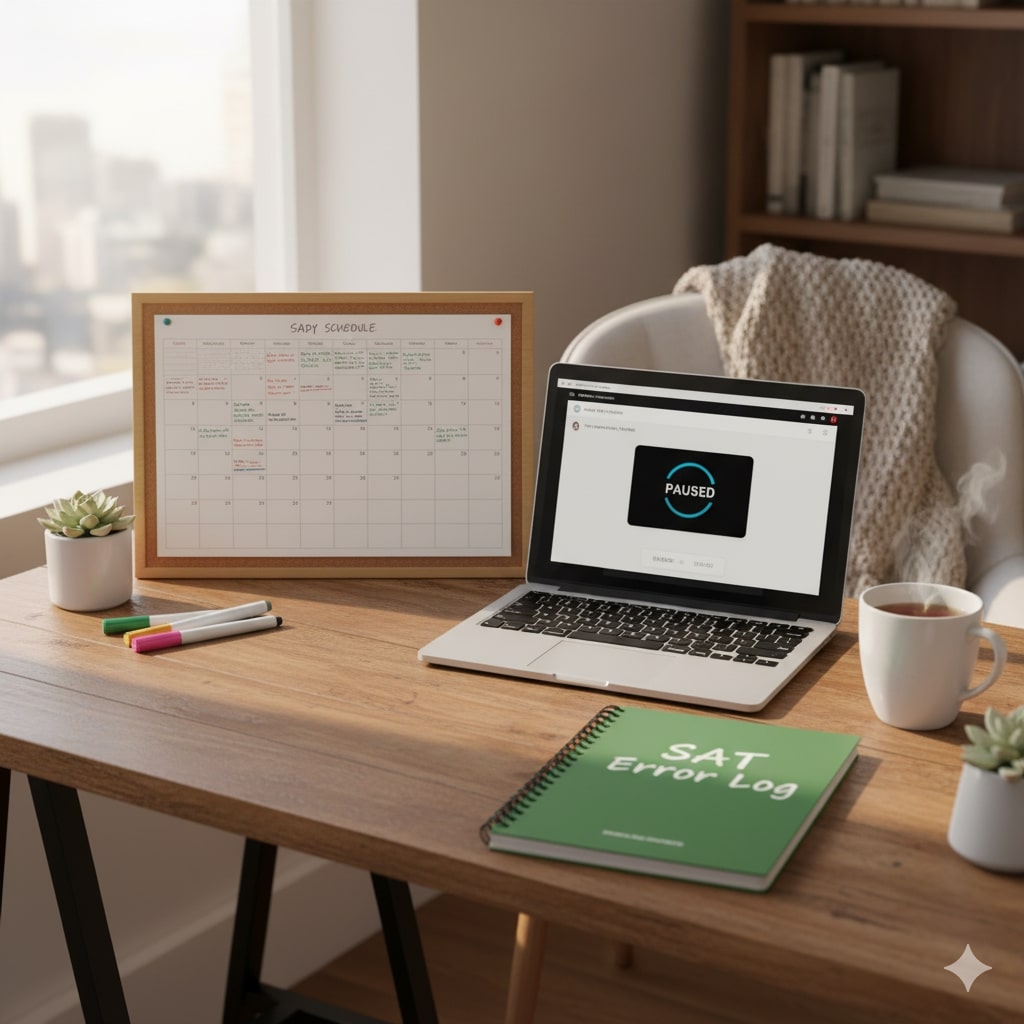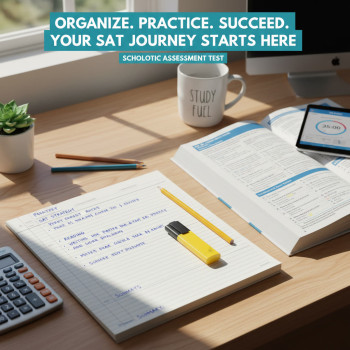Why last-minute SAT panic is more common than you think — and why it’s a problem
There’s a scene most students know well: it’s late, the test is tomorrow (or next week), and a dozen tabs, three practice tests, and half a stack of flashcards lie in a chaotic pile. Your heart races, your throat tightens, and the urge to cram everything into one hyper-focused, overnight study session feels almost irresistible. We get it. Panic can feel like productivity.
But let’s be real: on the modern Digital SAT, panic rarely helps. It can erode sleep, reduce focus, and make you more likely to make careless mistakes. The digital format—taken on a laptop or tablet using the Bluebook app—brings benefits like shorter test length and more time per question for many students. Those benefits are lost when your brain is fogged from last-minute cramming.
This post is a practical, calm, and human guide to why avoiding last-minute SAT panic matters and exactly what to do instead. No lectures, no fear-mongering—just clear strategies, realistic timelines, and examples you can start using tonight.
The real costs of last-minute cramming
Physical and mental toll
Cramming creates stress hormones, disrupts sleep, and lowers your ability to recall information accurately. Sleep consolidates memory; pulling all-nighters means your memory and reasoning won’t work as well the next day. You might feel like you learned something at 3 a.m., but between fatigue and stress, you’ll probably underperform.
Poor timing for digital test mechanics
The Digital SAT has some technical and strategic differences compared to older paper formats: adaptive sections, a digital interface, and built-in tools. If you haven’t practiced on the actual testing app or with full-length digital practice tests, last-minute studying won’t teach you how to pace yourself in that environment. You need to be comfortable not just with content but with the experience.
Lower returns and shaky confidence
Study science shows diminishing returns for intense short-term cramming versus spaced, active practice. You may feel productive during a cram session, but the gains are often shallow and short-lived. The result? A fragile sense of confidence that can collapse the moment you face a challenging question.
What’s a smarter alternative? The calm, structured path
Instead of panic, think planning. The difference is dramatic: planning reduces stress, improves retention, and gives you realistic checkpoints where you can measure progress.
Essential elements of a calm, effective study plan
- Start with a diagnostic full-length practice test on the Bluebook app (or an official digital practice test) to identify strengths and weaknesses.
- Create a weekly plan that focuses on one or two skill areas at a time (for example, algebra foundations + passage annotation skills).
- Blend targeted practice with mixed, timed sections to build stamina and timing skills.
- Schedule short, consistent study blocks rather than marathon sessions—quality beats quantity.
- Build in full-length, timed practice tests spaced every 2–3 weeks to track progress and adapt the plan.
How to build a practical SAT timeline (example)
Whether you have six months or six weeks, a plan that respects psychological and cognitive limits will always out-perform panic. Here’s a sample timeline you can adapt:
| Weeks before test | Focus | Actions |
|---|---|---|
| 24–12 weeks | Foundations & habits | Diagnostic, regular practice (3–5x/week), review fundamentals, start using spaced repetition for vocabulary and formulas. |
| 12–6 weeks | Skill-building & strategy | Target weak areas, practice grid-in and multiple-choice strategies, timed subsections, begin full digital practice tests every 2–3 weeks. |
| 6–2 weeks | Drill & timing | Focus on pacing, adaptive practice in Bluebook, mixed timed sections, analyze missed questions for patterns. |
| 2–0 weeks | Refine & rest | Light review, one or two final full-length practice tests, prioritize sleep and healthy routines, finalize test day checklist. |
This template respects both learning science and practical constraints like schoolwork and extracurriculars. Even if you only have a month, compress the steps but keep the same structure: diagnose, target, practice under timed conditions, then rest and solidify.
Practical study strategies that beat panic
1. Use active practice, not passive review
Active practice means doing problems, explaining answers out loud, and simulating test conditions. Passive review—rereading notes or watching solutions—feels productive but yields smaller learning gains. For example, instead of re-reading a grammar rule, pick five practice questions and explain why each wrong choice is wrong.
2. Short, frequent sessions (the 45/15 rule)
Work in concentrated 45-minute sessions followed by 15-minute breaks. Your brain stays alert, and you avoid burnout. During a 45-minute math session, do three timed sections of 12–15 minutes each, then review mistakes for 10 minutes.
3. Build your timing muscles with purposeful pacing
Timing isn’t just speed; it’s strategy. Practice when to slow down and when to skip. Many students assume every question must be answered in order—practice skipping and returning to optimize your score. Use the digital interface during practice so your muscle memory for navigation and annotation develops before test day.
4. Turn mistakes into a roadmap
Every missed question tells a story: a content gap, a careless error, or a timing issue. Keep a simple error log: question type, why you missed it, and a one-sentence plan to fix it. Over time, you’ll see clusters—then adjust your plan to target the true weaknesses.
5. Prioritize sleep, nutrition, and movement
These aren’t niceties—they’re test tools. Sleep consolidates memory; nutrition affects focus; short bursts of movement boost cognitive performance. Treat them as study investments. The week before the test, maintain regular sleep cycles and avoid drastic changes like all-night study sessions.
How to manage the week before the test without panicking
Two weeks before: taper intensity. Focus on review and light practice rather than new content. The goal is refinement, not speed-learning.
72-48 hours before
- Do one light, untimed practice section to stay sharp.
- Check your testing device and Bluebook app—make sure the app is installed and updated if you’ll use your own device.
- Prepare your test-day bag: charger, snacks, ID, water, simple notes for stress-breathing techniques.
24 hours before
- Do a relaxed review of high-yield formulas, grammar rules, and one light practice set—no full-length test unless it’s part of your normal routine.
- Aim for a consistent bedtime; avoid heavy screen time in the hour before sleep.
- Practice two or three calming techniques: box breathing, progressive muscle relaxation, or a five-minute walk.
Test morning
- Eat a balanced breakfast with protein and complex carbs.
- Give yourself extra time to set up your device and complete exam setup if required (this can be done days before, but double-check).
- Start the test calm and deliberate—your best performance comes from steady confidence, not adrenaline spikes.

Real student example: from panic to plan
Meet Maya, a fictional but realistic composite of dozens of students. Two months before her Digital SAT, she scored 1050 on a diagnostic. Panic set in because Maya balanced evening volleyball practice and a part-time job.
Her plan was simple: one focused hour five days a week, with weekend practice tests every other week. She used a short error log and switched to active practice—doing problems, explaining them to a friend, and timing sections in the Bluebook app. Her tutor (who provided 1-on-1 guidance) helped prioritize a tailored study plan that concentrated on algebra fundamentals and evidence-based reading strategies.
Result: steady improvement, less stress, and a final test where Maya felt in control. That’s the point—preparation isn’t about eliminating nerves; it’s about replacing panic with confidence.
How personalized support can prevent crisis-mode studying
Personalized help matters because it shortens the path from diagnosis to improvement. When you have limited time, a tutor or coach can identify the high-leverage changes that move your score the most. For many students, Sparkl’s personalized tutoring—offering 1-on-1 guidance, tailored study plans, expert tutors, and AI-driven insights—fits naturally into a calm plan. The right tutor won’t encourage cramming; they’ll help you build efficient habits, set realistic target milestones, and provide the accountability that prevents last-minute panic.
Quick fixes that actually work (and those that don’t)
Good quick fixes
- Targeted review of the most-missed question types from your last practice test.
- Timed 30–45 minute practice sections to rehearse pacing, not content volume.
- Sleep and a nutritious meal the night before and the morning of the test.
- Breathing exercises to reduce acute anxiety before and during the exam.
Bad quick fixes (avoid these)
- Trying to learn whole new chapters in one night.
- Excessive caffeine or stimulants to stay awake.
- Relying on random question dumps or low-quality practice without reviewing mistakes.
- Skipping practice in the Bluebook environment—knowing the interface matters.
Practical tools and routines to adopt today
- Install and explore the Bluebook app now so you’re comfortable with digital navigation.
- Keep a two-column error log: (1) concept missed; (2) corrective action. Review weekly.
- Create a “test day kit” checklist and rehearse the morning routine once before the real test day.
- Use short, active sessions and one full-length practice test every 2–3 weeks to assess progress.
When last-minute review is okay (and how to do it right)
Not all last-minute studying is bad. If you’ve already prepared and are reviewing in the final 48–72 hours, prioritize light, confidence-boosting activities:
- Review a concise list of high-yield formulas and rules you’ve already practiced.
- Do one short, low-stress practice set to stay sharp—don’t overdo it.
- Practice calming techniques and logistical checks so test day feels routine not chaotic.
The goal is to reinforce what you know, not to learn new methods or content at the eleventh hour.
Final thoughts: make peace with steady progress
Panic is noisy and tempting. Planning is quieter and far more effective. If you move from last-minute scrambling to a calm, structured approach—even if it’s just trimming down your cramming and adding a few focused practice sessions—you’ll see better scores and feel better on test day.
And remember: help is a tool, not a crutch. Whether it’s a trusted tutor, a friend who quizzes you, or a personalized program like Sparkl that offers 1-on-1 guidance, tailored study plans, expert tutors, and helpful AI-driven insights, the right support will reduce panic and keep your study time productive.
Checklist: your anti-panic plan (48-hour summary)
- 48–72 hours out: light review and one short, untimed practice section; check Bluebook and device.
- 24 hours out: pack test-day bag, sleep early, light review only.
- Morning of test: balanced breakfast, calm breathing, arrive early to set up device.
- During test: pace deliberately, skip-and-return strategy, use breaks to reset.
One final encouragement
You don’t have to be perfect. You don’t have to know everything. What matters is steady, targeted practice and a calm plan. Replace panic with a plan, and the Digital SAT will feel like one more challenge you can handle—not a stress storm you have to survive.
If you’d like, I can help you build a personalized, panic-proof study plan based on how much time you have and your diagnostic score. Small steps now beat big nerves later—let’s make a plan that fits your life.



















No Comments
Leave a comment Cancel